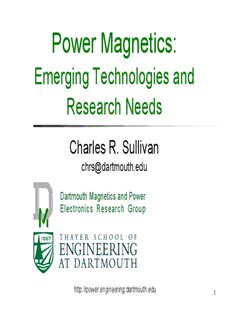
Power Magnetics: Emerging Technologies and Research - ARPA-E PDF
Preview Power Magnetics: Emerging Technologies and Research - ARPA-E
Power Magnetics: Emerging Technologies and Research Needs Charles R. Sullivan [email protected] Dartmouth Magnetics and Power Electronics Research Group http://power.engineering.dartmouth.edu 1 Why Magnetics? Magnetics (inductors and transformers) are (cid:132) required for most power conversion circuits, but are responsible for much of the Size (volume and weight) (cid:132) Power loss (cid:132) Cost (cid:132) Difficulty in design (long development cycles) (cid:132) Advances depend on magnetics: (cid:132) High frequency circuits for miniaturization. (cid:132) Resonant circuit designs. (cid:132) power.thayer.dartmouth.edu 2 Directions not mutually exclusive Miniaturization: Very high frequency, integrated, thin-film, small, and (eventually) low cost. Ultra-high efficiency: Efficiencies in the high 90’s without increasing size or cost. High-power High-frequency, high-efficiency at multi-MW scale. power.thayer.dartmouth.edu 3 Minaturization General idea: for given impedance (cid:132) Z = jωL, the inductance needed goes down with frequency. Similar scaling for transformers. (cid:132) Actual scaling depends on material (cid:132) properties (with a magnetic core). Examine “performance factor” B·f….. (cid:132) power.thayer.dartmouth.edu 4 “Performance factor” for 40 mT MnZn power ferrites Curves of B·f (cid:132) 30 kHz·T product for constant power loss density… 200 mT No benefit from (cid:132) 20 kHz·T f > ~ 1 MHz. Need different (cid:132) materials for higher frequency. plotted for 300 mW/cm3 100 kHz 1 MHz power.thayer.dartmouth.edu 5 Air-core vs. magnetic core Magnetic coil coil Core: soft magnetic material “Air core” with relative (cid:132) Magnetic core (cid:132) is really any permeability increases L (inductance) non-magnetic, by a factor μ , μ >> 1 r r dielectric typ. 4 ~10,000 material. Allows smaller volume, (cid:132) (B = μ ·μ H) · fewer turns for same L r 0 power.thayer.dartmouth.edu 6 The case for air-core At very high frequencies (cid:132) (e.g. VHF = 30 MHz to 300 MHz), the inductance value is small and readily achievable without magnetic materials. Always gets better at higher frequency: (cid:132) At constant η (constant Q): Volume proportional to f -3/2 At constant heat flux: Volume proportional to f -1/2 with Q improving as f 1/3 Avoid magnetic material disadvantages: (cid:132) Power losses due to hysteresis and eddy currents. (cid:132) Frequency limitations: any material gets too lossy above some (cid:132) frequency, often only a few MHz. Not available in standard IC or packaging processes. (cid:132) power.thayer.dartmouth.edu 7 Air-core challenges Low permeability leads to low flux density, which (cid:132) requires substantial volume for sufficient flux. Requires more turns → more winding loss. (cid:132) Flux is not contained by a core; external flux can (cid:132) cause EMI problems and eddy-current loss in nearby conductors. Requires significant air volume. (cid:132) power.thayer.dartmouth.edu 8 Air-core geometries Our work C.P. Yue, CMU Toroid Planar spiral No external flux (cid:132) Flux in substrate, (cid:132) problem. surroundings. Field is parallel to (cid:132) Field perpendicular to (cid:132) conductor: low eddy conductor: high eddy currents. currents. Easy to make. Harder to make. (cid:132) (cid:132) Typical Q: Q: can be > 100 (cid:132) (cid:132) < 10 for 1 GHz < 4 for 100 MHz power.thayer.dartmouth.edu 9 Air-core performance limits Field between two (cid:132) layers of copper (e.g. large-footprint toroid) 100 Q m u m Can do better with i (cid:132) x a multilayer copper M 100 MHz 300 MHz 30 MHz (in theory): 10 improve by a factor p where p is number of copper layers. Requires height for 1 (cid:132) flux path! 10 μm 100 μm 1 mm Packaging layer vs. (cid:132) Height on-chip. power.thayer.dartmouth.edu 10
Description: